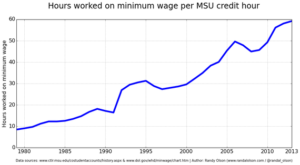Years ago, a hardworking college student could earn enough money in a summer of life-guarding or burger flipping to pay for one year of college tuition. If she continued to work for wages for as many hours as possible during the school year, lived in a tiny apartment with multiple roommates, and ate only macaroni and cheese, she might be able to cover her own living expenses during the school year as well. Is this still the case?
No; it’s not.
Students can no longer pay for their own college by working a minimum wage job.

photo credit: Jobs Help Wanted via photopin (license)
Because of rising tuition costs, it’s no longer possible for college students to earn enough money to pay for college tuition as they go.
Parents, let me give you a better plan for getting your child through college debt-free.
This article in The Atlantic explains it well.
In 2014, Svati Kirsten Narula reported in The Atlantic: “The average student in 1979 could work 182 hours (a part-time summer job) to pay for a year’s tuition. In 2013, it took 991 hours to accomplish the same.”
Narula bases her math on this example: “A credit hour in 1979 at Michigan State University was $24.50, adjusted for inflation that is $79.23 in today dollars. One credit hour today costs $428.75.”
The numbers show — working your way through college is nigh unto impossible in this day in age. Families need a better plan than this.
The bottom line for students is that, according to Narula, “In 1979, when the minimum wage was $2.90, a hardworking student with a minimum-wage job could earn enough in one day (8.44 hours) to pay for one academic credit hour.” That seemed reasonable. All a student would have to do is work 18 days like that, and he’d have one semester of tuition paid for. Today’s hard truth, though, is that even though Michigan minimum wage is now $7.40 per hour, a college student would have to work seven straight days to pay for one credit hour at Michigan State University. He’d have to work full time for 25 straight weeks, all the way from Labor Day to March, just to pay his college tuition. Living expenses would be extra.
“The price of an MSU education began exceeding what could reasonably be earned with part-time, minimum-wage work around 1993,” reports Narula. “That’s when a single MSU credit hour became worth more than 20 hours of wages.”
Narula’s article includes this graph, created in April of 2014 by MSU graduate student Randy Olson:
Olson’s conclusion: “It’s impossible to work your way through college nowadays.”
Of course, these calculations cannot be considered to be entirely accurate, because they don’t include taxes or academic year room and board. Average tuition at the least expensive four year public universities in the U.S. is currently approximately $8,893, but add on room and board and the sad reality that many students just can’t graduate from these institutions in four years, and the total average cost of college exceeds a whopping $18,391 per year. A college student would have to work a minimum wage job more than 60 hours a week for 50 straight weeks to pay that.
So, should a student work for money during college anyway — even though it won’t pay the whole bill?
Yes.
Your child should absolutely work for wages during summers and during the academic years while he or she is in college. (The best kind of job to get? A tuition reimbursement job, which I talk about in detail in this post.) But make no mistake, this work is not going to cover the cost of his college tuition and living expenses. Good quality parental strategy (that parents have started on well ahead of time) is going to accomplish that.
What parents can do to help, starting right now.
To get your family started on the path to debt-free college now, click on your child’s age in the “WHAT TO DO WHEN” section on this website. I’ll be able to give you free, clear, step-by-step help getting your kid through college debt-free. Start early though; debt-free college is easiest to accomplish if parents start when their kids are in middle school.
This post is Part 2 of a 3-part series.
To see two more posts from me on the subject of students working for money while going to college, subscribe to my email newsletter using the form on this website.
Important—> It’s a reference book, so nobody reads the whole thing cover to cover. Pick out what you need to read in it using the fast-paced, 10-minute video instructions here.
You can see hundreds of reviews of this book on Amazon by going to:
Read just one chapter of LAUNCH every 1–3 months while your child’s in middle school and high school, and you’ll know every viable strategy for debt-free college at exactly the right time to implement it.
And if your child’s already well past middle school? That’s OK; you can run to catch up. But the process of getting your kids through college debt-free goes more smoothly the earlier you start—especially if you’re not planning to save up any money to pay for college.
Let's you and I walk together toward the goal of debt-free college for your kids.
We can accomplish this no matter your current income level—even if your kids never get a single scholarship.
Your first step is getting regularly scheduled, free helpful articles from me—right in your email inbox. Quick, sign up here.
Do you have very specific questions for me about debt-free college and career for your kids?
My TRIBE Members get the most direct access to me—while feeling good that the pennies per day they spend on the TRIBE help me bring debt-free college strategy to families who could never afford to pay for it. Join my TRIBE Membership waiting list here.
Who is Jeannie Burlowski?
Jeannie is a full-time academic strategist, podcast host, and sought-after speaker for students ages 12–26, their parents, and the professionals who serve them. Her writing, speaking, and podcasting help parents set their kids up to graduate college debt-free, ready to jump directly into careers they excel at and love. Her work has been featured in publications such as The Huffington Post, USA Today, Parents Magazine, and US News & World Report, as well as on CBS News.
Jeannie also helps students apply to law, medical, business, and grad school at her website GetIntoMedSchool.com. You can follow her on Bluesky @jburlowski.bsky.social.
No part of this article was written using AI.



